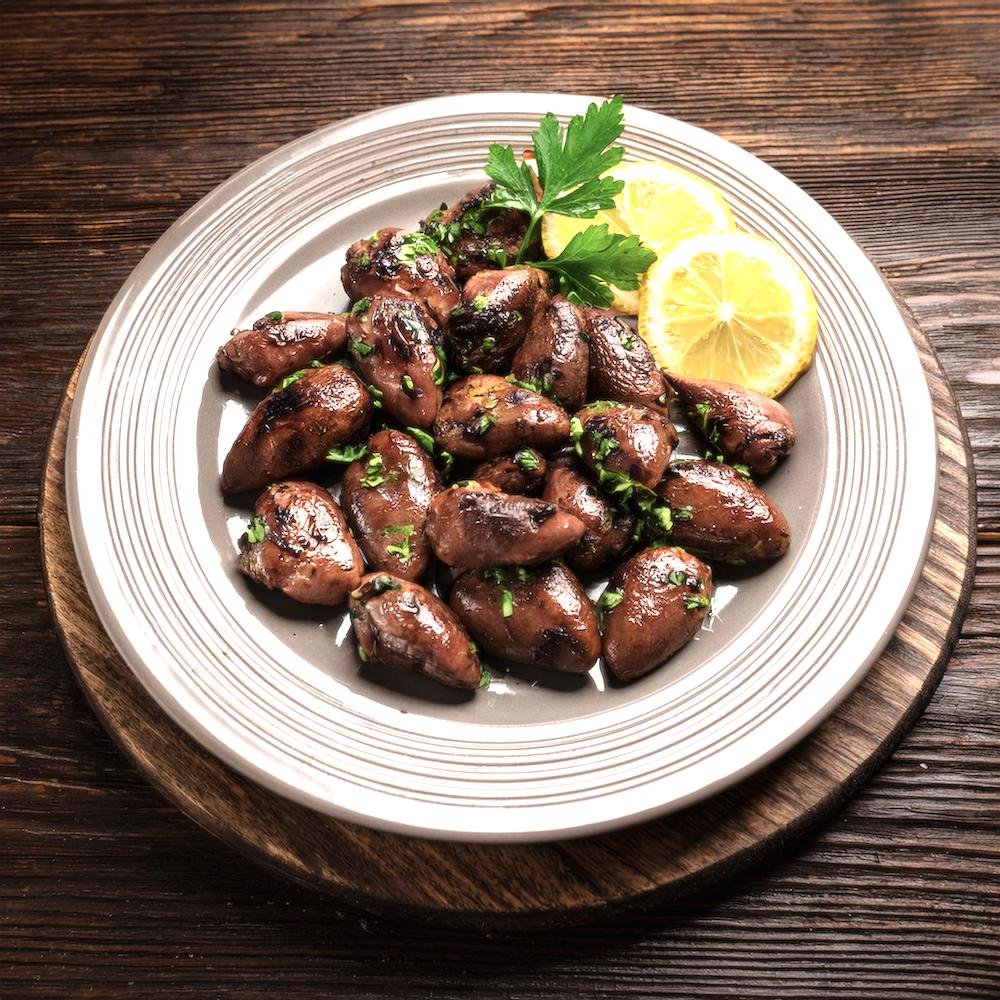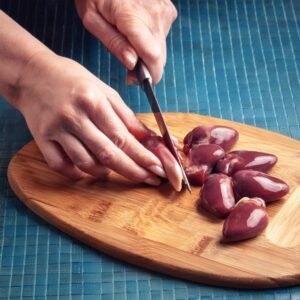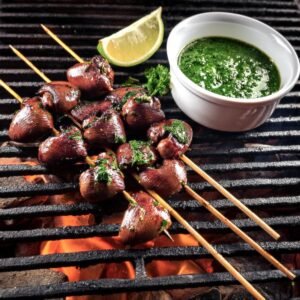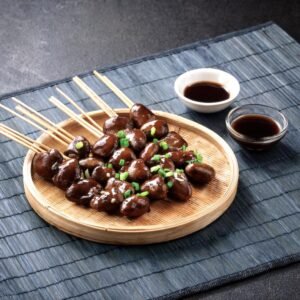Chicken hearts are a nutrient-packed ingredient that has gained popularity in cuisines worldwide. These small, protein-rich organs are both economical and delicious when prepared correctly. Their unique texture and savory flavor make them a standout in a variety of traditional and modern recipes, whether grilled, sautéed, or stewed.
This article dives into their nutritional benefits, preparation tips, popular recipes, and cultural significance. If you’re seeking a healthy, flavorful addition to your meals, chicken hearts are an excellent choice to explore!
Nutritional Benefits
Chicken hearts are more than just a tasty treat; they’re also a powerhouse of essential nutrients. Here’s a breakdown of why they’re considered a healthy addition to your diet:
1. High in Protein
- Chicken hearts are packed with high-quality protein, which is essential for muscle growth, repair, and overall body function.
- A 100-gram serving of chicken hearts provides approximately 17 grams of protein.
2. Rich in Micronutrients
Iron
- Supports the production of hemoglobin and helps prevent anemia.
- Ideal for individuals with iron-deficiency concerns, especially those following a high-protein diet.
Zinc
- Boosts immune system function and supports skin health.
- It is an excellent source of zinc, making them beneficial for overall well-being.
Vitamin B12
- Promotes healthy nerve function and energy production.
- It is a rich source of this vitamin, particularly important for those seeking to maintain optimal cognitive health.
3. Low in Calories and Carbs
- With only about 130 calories per 100 grams, chicken hearts are a low-calorie protein source.
- They contain minimal carbohydrates, making them a perfect fit for low-carb and keto diets.
4. Healthy Fats
- While contain some fat, they are relatively low in saturated fats and include beneficial omega-6 fatty acids.
5. Nutrient-Dense for Active Lifestyles
- Due to their protein and micronutrient content, It is an excellent option for athletes and active individuals looking for energy-boosting foods.
How to Prepare
Preparing is a straightforward process, but proper cleaning and cooking techniques are essential to maximize their flavor and texture. Here’s how to get them ready for your favorite recipes.
1. Cleaning Chicken Hearts
Why Cleaning is Important
- It is often come with residual blood or connective tissue that can affect their taste and texture. Cleaning ensures a more appealing dish.
Steps for Cleaning
- Rinse Thoroughly:
- Place it in a colander and rinse under cold running water to remove any surface debris.
- Trim Excess Fat and Tissue:
- Use a sharp knife or kitchen scissors to trim off visible fat, connective tissue, or blood vessels.
- You can cut larger hearts in half for faster cooking or leave them whole for skewers and grilling.
- Soak for Extra Cleanliness:
- Optional: Soak It in cold water with a splash of vinegar for 10–15 minutes. This helps remove any lingering impurities and tenderizes the meat.
2. Marinating for Enhanced Flavor
Why Marinate?
- Chicken hearts have a mild flavor that absorbs marinades exceptionally well. Marinating adds depth and keeps them juicy during cooking.
Simple Marinade Recipe
- Ingredients:
- 3 tablespoons soy sauce
- 1 tablespoon olive oil
- 2 cloves garlic, minced
- 1 teaspoon smoked paprika
- Juice of 1 lemon
- Salt and pepper to taste
- Instructions:
- Combine all marinade ingredients in a bowl.
- Add the cleaned chicken hearts and toss to coat evenly.
- Cover and refrigerate for at least 30 minutes (or up to 12 hours for more intense flavor).
3. Best Cooking Methods
Grilling
- Skewer the marinated hearts and grill over medium-high heat for 2–3 minutes per side until cooked through.
- Great for Brazilian-style barbecue or yakitori-inspired dishes.
Pan-Frying
- Heat a skillet with a tablespoon of oil and sauté the hearts for 5–7 minutes, stirring frequently.
- This method works well for stir-fries or as a topping for salads.
Braising
- Simmer the hearts in a flavorful liquid (like broth, wine, or tomato sauce) for 20–30 minutes.
- Ideal for stews and dishes where a tender, melt-in-your-mouth texture is desired.
Roasting
- Spread the hearts on a baking sheet, season with your favorite spices, and roast at 400°F (200°C) for 15–20 minutes.
- A quick and easy option for crispy, flavorful hearts.
4. Pro Tips for Perfect
- Don’t Overcook: Chicken hearts cook quickly. Overcooking can make them tough and chewy. Aim for an internal temperature of 165°F (74°C).
- Season Liberally: Their mild flavor benefits from bold spices like paprika, cumin, garlic powder, or chili flakes.
- Pair with Bold Sides: Serve with chimichurri, garlic rice, or a fresh green salad for a complete meal.
Popular Recipes Using Chicken Hearts
Chicken hearts are a versatile ingredient that can be prepared in various ways, from grilling to stewing. Here are some popular recipes to inspire your next meal and showcase the unique flavor of this protein-packed delicacy.
1. Grilled Chicken Hearts (Brazilian Style)
Ingredients
- 1 pound chicken hearts, cleaned
- 3 tablespoons olive oil
- 2 cloves garlic, minced
- 1 teaspoon smoked paprika
- 1 teaspoon cumin
- Salt and pepper to taste
- Lemon wedges for serving
Instructions
- Marinate: Combine olive oil, garlic, smoked paprika, cumin, salt, and pepper in a bowl. Add chicken hearts and toss to coat. Marinate for at least 30 minutes.
- Skewer: Thread chicken hearts onto metal or wooden skewers.
- Grill: Preheat the grill to medium-high heat. Grill skewers for 2–3 minutes per side, until cooked through.
- Serve: Squeeze fresh lemon juice over the hearts before serving. Pair with rice or a chimichurri sauce.
2. Chicken Heart Stir-Fry
Ingredients
- 1 pound chicken hearts, cleaned and halved
- 2 tablespoons soy sauce
- 1 tablespoon sesame oil
- 2 cloves garlic, minced
- 1 teaspoon ginger, grated
- 1 red bell pepper, sliced
- 1 cup snap peas
- 1 tablespoon oyster sauce
Instructions
- Sear the Hearts: Heat sesame oil in a wok or skillet over high heat. Add chicken hearts and cook for 3–4 minutes until browned. Remove and set aside.
- Cook Vegetables: Add garlic, ginger, bell pepper, and snap peas to the wok. Stir-fry for 2–3 minutes.
- Combine: Return chicken hearts to the wok, add soy sauce and oyster sauce, and stir-fry for 2 more minutes. Serve over steamed rice.
3. Braised Chicken Hearts with Garlic and Herbs
Ingredients
- 1 pound chicken hearts, cleaned
- 2 tablespoons olive oil
- 4 cloves garlic, minced
- 1 cup chicken broth
- ½ cup white wine
- 1 teaspoon thyme
- 1 teaspoon rosemary
- Salt and pepper to taste
Instructions
- Sear the Hearts: Heat olive oil in a pan over medium heat. Add chicken hearts and sear until browned on all sides.
- Add Aromatics: Stir in garlic, thyme, and rosemary. Cook for 1 minute.
- Braise: Pour in chicken broth and white wine. Reduce heat, cover, and simmer for 20–30 minutes until tender.
- Serve: Serve with mashed potatoes or crusty bread to soak up the flavorful sauce.
4. Skewered Chicken Hearts (Japanese Yakitori)
Ingredients
- 1 pound chicken hearts, cleaned
- 3 tablespoons soy sauce
- 2 tablespoons mirin
- 1 tablespoon sake
- 1 teaspoon sugar
- 1 teaspoon grated ginger
Instructions
- Make the Marinade: Combine soy sauce, mirin, sake, sugar, and ginger in a bowl. Add chicken hearts and marinate for 1 hour.
- Prepare Skewers: Thread hearts onto skewers, leaving small gaps between them.
- Grill: Cook over medium-high heat, brushing with extra marinade during grilling, for 2–3 minutes per side.
- Serve: Garnish with green onions and serve with steamed rice or miso soup.
5. Crispy Fried Chicken Hearts
Ingredients
- 1 pound chicken hearts, cleaned
- 1 cup buttermilk
- 1 cup flour
- 1 teaspoon paprika
- 1 teaspoon garlic powder
- Salt and pepper to taste
- Oil for frying
Instructions
- Soak in Buttermilk: Marinate chicken hearts in buttermilk for 1 hour to tenderize.
- Coat in Flour Mixture: Combine flour, paprika, garlic powder, salt, and pepper in a bowl. Dredge hearts in the mixture.
- Fry: Heat oil in a skillet over medium-high heat. Fry hearts until golden brown and crispy, about 3–4 minutes per batch.
- Serve: Serve with a dipping sauce like ranch or hot sauce.
Cultural Significance of Chicken Hearts
Chicken hearts are more than just a culinary ingredient—they hold cultural and traditional importance in cuisines across the globe. Their affordability, flavor, and nutritional benefits have made them a popular choice in various cultures for centuries. Let’s explore how chicken hearts are celebrated and used in different parts of the world.
1. Brazilian Cuisine
Churrasco Tradition
- It is a staple at Brazilian churrasco (barbecue). They’re marinated, skewered, and grilled to perfection, often served alongside other meats.
- Known as “Coraçãozinho,” they are considered a delicacy and are a favorite among churrasco lovers.
Why They’re Loved
- Brazilians appreciate the tender texture and rich flavor of chicken heart, which pair beautifully with traditional sides like farofa and chimichurri.
2. Japanese Cuisine
Yakitori Skewers
- Chicken heart, or “hatsu,” are a popular item at Japanese izakayas (casual pubs). They’re grilled on skewers and basted with a tare sauce (soy sauce, mirin, and sake mixture).
- Often served with green onions and a sprinkle of togarashi (Japanese chili powder) for added flavor.
Cultural Importance
- Yakitori skewers are a representation of Japan’s “nose-to-tail” culinary philosophy, ensuring every part of the animal is utilized and respected.
3. Southeast Asian Cuisine
Street Food Favorites
- In countries like the Philippines, Thailand, and Indonesia, chicken hearts are commonly found at street food stalls, grilled over charcoal and served with dipping sauces.
- They’re often paired with spicy, tangy sauces that complement their natural flavor.
Affordable Protein Source
- It is valued for their affordability and nutritional content, making them an accessible protein source for many families.
4. Eastern European Cuisine
Hearty Stews
- It is used in traditional stews and soups in countries like Poland and Hungary.
- They’re slow-cooked with vegetables and spices to create comforting, flavorful dishes.
Connection to Rural Traditions
- In Eastern Europe, It is part of a “farm-to-table” approach, reflecting a resourceful use of all parts of the animal.
5. Modern Fusion Cuisine
Elevated Restaurant Dishes
- In contemporary kitchens worldwide, chefs are incorporating chicken heart into fine-dining menus, highlighting their flavor and versatility.
- They’re often paired with bold seasonings, citrus-based sauces, or creative plating to appeal to adventurous diners.
Why Chicken Hearts Hold Cultural Value
- Sustainability: Using chicken heart reflects a sustainable approach to cooking, minimizing food waste.
- Tradition: Chicken heart often evoke nostalgia, reminding people of family recipes and cultural heritage.
- Community: Dishes featuring chicken heart are often served at communal gatherings, emphasizing their role in bringing people together.
Frequently Asked Questions (FAQs)
Are chicken hearts good for you?
Yes, It is highly nutritious and provide numerous health benefits:
Rich in Protein: They are an excellent source of high-quality protein, essential for muscle growth and repair.
Packed with Nutrients: It is rich in iron, zinc, vitamin B12, and other essential micronutrients, supporting energy production, immunity, and overall well-being.
Low in Calories: They are low in calories and carbohydrates, making them suitable for keto, low-carb, and weight management diets.
Healthy Fats: While they contain some fat, it’s predominantly healthy fats like omega-6 fatty acids.
What does a chicken heart taste like?
It have a unique taste and texture:
Flavor: They have a mild, slightly gamey flavor, often compared to dark chicken meat. The taste is rich and savory but not overpowering.
Texture: When cooked properly, It is tender with a slight chewiness. They absorb marinades and seasonings exceptionally well, making them versatile in different recipes.
Do chicken hearts need to be cleaned?
Yes, cleaning It is essential before cooking to remove any impurities:
Rinse: They should be rinsed thoroughly under cold water to remove surface blood and debris.
Trim: Use a knife or scissors to remove excess fat, connective tissue, or blood vessels.
Optional Soak: Soaking in cold water with a splash of vinegar for 10–15 minutes can help remove any residual impurities and tenderize the hearts.
Are chicken hearts gizzards?
No, chicken hearts and gizzards are different parts of the chicken:
Chicken Hearts: These are the actual hearts of the chicken, small and rounded with a rich, meaty flavor.
Chicken Gizzards: Gizzards are part of the chicken’s digestive tract, responsible for grinding food. They have a tougher texture and require longer cooking to become tender.
Both chicken hearts and gizzards are nutritious and often used in similar recipes.
Suggested Internal Links:
- Are Chicken Hearts Good for You?
Learn about the nutritional benefits and health considerations of eating chicken hearts. - What Does a Chicken Heart Taste Like?
Discover the flavor profile of chicken hearts and how they can be prepared. - Do Chicken Hearts Need to Be Cleaned?
Step-by-step guide on cleaning chicken hearts before cooking. - Are Chicken Hearts Gizzards?
Clarify the differences between chicken hearts and gizzards for culinary use. - What Does Tarragon Taste Like in Chicken?
Enhance your chicken heart recipes with the unique flavor of tarragon.
Conclusion
Chicken hearts are a delicious, nutrient-dense ingredient that deserves a place in your kitchen. Their versatility, affordability, and cultural significance make them a valuable addition to a wide range of dishes, from grilled skewers to hearty stews. Packed with protein, iron, and essential vitamins, It is offer both health benefits and culinary satisfaction.
Whether you’re inspired by Brazilian churrasco, Japanese yakitori, or Southeast Asian street food, It is provide an excellent opportunity to explore new flavors and cooking techniques. Try them grilled, stir-fried, or braised, and share your creations with friends and family. Who knows—they might become a new favorite!
Discover more mouthwatering recipes on our Web Site ! Stay connected and get inspired by following us on Facebook, Instagram, Pinterest, and Twitter for the latest updates!




